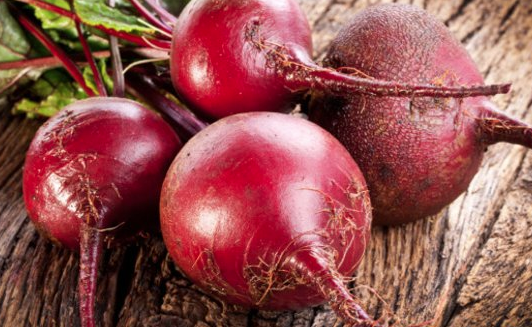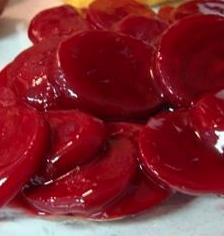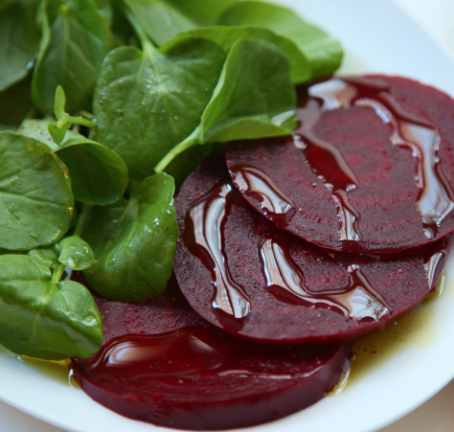
Mention beets to a certain generation and you might get a knowing look of longing.
A newer generation might stare quizzically at you, confused as to why you’re referencing their technology in the same sentence as roasting and slicing.
The generation in between, my generation, will probably wrinkle their noses in disdain, bordering on disgust. We are the boiled beet generation, the kids who grew up with pots of beets cooking away on stoves all over America, served by mothers who endured the same torture when they were your age. It’s a chilling thought to consider that this whole act was intentional. I’d like to think my mother overcooked beets because that was the only way offered at the time. The alternative as I remember was a jar of pickled beets which she would buy every once in a while and which after a few desultory attempts would end its life at the back of our fridge. There was no roasted beet with herbed goat cheese salad, or beet beurre blanc with grilled salmon. Canned, pickled, boiled, take your pick.
Redemption, I believe, came in the form of farm to table eating.

When a restaurant advertises seasonal eating, the concept collides with reality in January and February. Although we have a long growing season in Kentucky, most of our “sexy” vegetables are gone by Thanksgiving. The idyllic picture of sun-kissed tomatoes and vibrant herbs gives way to the cold, harsh reality of root vegetables, potatoes and hard winter squash. You can choose to serve only what is local, which reduces your menu down to the bare essentials or you can adjust your menu to incorporate what’s in season, and then source what you can of that on a regional or local level. Along the way, chefs discovered or re-discovered root vegetables like turnip and parsnip, winter greens, and the beet.
At first, it was only red beets, big, ungainly lumps, grown too large for the flavor to be clean and plating to be possible with a single beet. As was the case with other crops like micro greens and even carrots, everything then started to trend downward, both in size and in the amount of time the beet spent in the ground. Small beets with sweet crisp flavor morphed into a rainbow of colors, as chefs consulted with farmers to rehabilitate the vegetable.
It was a case of mutual survival; chefs needed something to cook, farmers needed something to grow and sell.
It is a microcosm of dependency that is repeated every season with many different vegetables. Once beets started showing up on plates, most diners were intrigued. Some of the more intrepid ones, sensing that the old beet was gone, dove right in and enjoyed bit of an epiphany; these beets were nothing like the old ones. Credit the smaller, more tender beet with a reduction in cooking time and a lessening of the bitter, muddy taste that often accompanied long-cooking large, older beets.

Heck, with these new beets you could even shave them thinly, dress them with a vinaigrette and sell them as a salad. This opens up a whole area of prep and presentation previously not available. Turns out it also opened up another season for the farmers, as they found that the shorter growing season meant sneaking a spring crop in as well. Clean sweet flavors, sweet and less fibrous, individually sized for optimum versatility, the stage was set for a beet renaissance. Except, there are still hurdles to overcome.
Because beets were ill-used there was very little information on flavor profiles and food parings. Worse yet were the issues that root vegetables often present when pairing with wine, beer or alcohol. Chefs with les experience still hesitate to work with the beets. Adventurous chefs or ones experienced in the cuisines that featured beets knew enough to coordinate colors, tannins and sugars in various forms to balance the earthiness of the beet, another obstacle passed.
So why is it that beets still don’t command respect on a seasonal menu? For myself, they still do not present themselves as readily to my internal grocery list as other vegetables do. I cook all sorts of winter vegetables for the winter menu, and it takes a lot of effort to remember that beets should be part of that.
When my local purveyors have beets I generally will buy them. But there again, if I’m the only one, why grow them at all?

That’s where C.S.A.s come in handy. If my customer is being introduced to them, and they demand that I have them, then the farmer has killed two birds with one stone, and I get to build a beet “support group” that closes and continues the circle. So, the next time you see beets on my menu or any other for that matter, consider digging in. These aren’t the beets that drove you away, hopefully they’ll be the ones that bring you home.
My cooking method for beets has changed over the years. I used to roast them in their skins, cool and then peel and cut. From that point on I could finish them in any manner I chose. The one drawback is the loss of moisture and shrinkage so I’ve amended the cooking method to a wet heat method. I simmer the beets, (not boil) in their skins until they are tender. I let them cool in the water, and then store them in their skins. This gives me great versatility to roast or sauté or slice thinly and serve cold without losing color, texture or moisture. Storing cooked beets in their skin gives them a longer shelf life and prevents all the color from draining out.
There is a wide variety of flavors, ingredients and textures that compliment beets. Cheeses with softness, richness and tanginess such as goat and aged cheddar blend well with the earthy sweetness of beets. Bacon, pancetta, ham and cured meats offset some of the sharpness with the mellow, rich saltiness of the cured pork. Smoke, in the form of bacon or literally smoked, even on a grill adds more of the same earthiness that beets are known for. Perhaps the best blend though is acid. Roasted beets with a citrus vinaigrette, sliced cold with blood orange reduction, quickly sautéed with shallot and lemon juice. Finally, roasting the blanched beet with some of its own kin; carrot, parsnip and turnip is the perfect side for a cold winter’s night leg of lamb.
John Foster is an executive chef who heads the culinary program at Sullivan University’s Lexington campus. A New York native, Foster has been active in the Lexington culinary scene and a promoter of local and seasonal foods for more than 20 years. The French Culinary Institute-trained chef has been the executive chef of his former restaurant, Harvest, and now his Chevy Chase eatery, The Sage Rabbit.
To read more from Chef John Foster, including his recipes, click here.

























